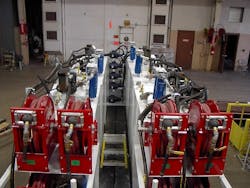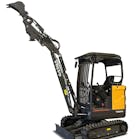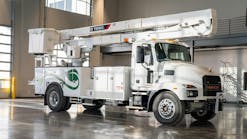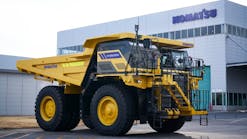Don’t Trust New Oil-change Intervals
Tier 4-powered equipment moves into fleets with greater recommended oil-change intervals, often doubling from 250 to 500 hours, says Ken Hill, CESP and vice president of sales and marketing at WearCheck, an international oil condition-monitoring service. His advice, however: Use those suggested intervals as a starting point, not necessarily as the final answer.
“Some of the manufacturers are saying that as long as you’re using a premium CJ-4 oil with good dispersant properties in the Tier 4 diesel engines, you can increase your drain times from 250 to 500 hours,” he says. “However, Tier 4 engines with EGR systems require cooling components, and those coolers create more opportunities for coolant fluids to get into the oil. We are seeing more glycol in the off-road oil analyses now, and glycol is the worst thing to get in the engine. [It is] even worse than dirt because when glycol heats up, it becomes acidic and will corrode the engine.”
Hill says using oil-analysis that includes total base number (TBN) data may also show that the current oil has more serviceable hours left in it and doesn’t need to be drained just yet. Hill calls this “conditional maintenance,” and prefers it to standard preventive or predictive maintenance.
“Conditional maintenance schedules take into account what is really happening in the engine,” he says. “A contractor might find that he should back down from that 500-hour oil drain interval and go to a 300-hour drain based on analysis data that shows too much soot is left at 500 hours. Or, he may see the oil’s TBN percentage is still high enough to keep the acids down adequately during the combustion process, and he can let the machine run safely a little longer before the system needs to be drained.
“[That] saves labor, storage and money.”
But managing the increasing assortment of oils, lubes and greases recommended for each machine’s engine and components, combined with following vendor and OEM preventive maintenance intervals, is leaving managers feeling the strain on their time, organization and bottom lines. Emissions and fuel economy goals aren’t going to lessen the lubricant and fluid choices presented to a fleet manager, so here are some strategies and suggestions that are helping several companies stem the tide of their lubricant tsunamis.
Ron Jankowski is the parts and fleet services manager for Madison, Wisconsin’s fleet of about 1,200 vehicles, serviced in Madison’s main shop and at four satellite locations. The City’s equipment ranges from backhoe loaders to squad cars, so Jankowski depends on the expertise of Madison’s full-time preventive maintenance technician whose job it is to analyze parts, products and recommendations listed in the owners and operators manuals for every piece of equipment the city purchases. The PM technician also tracks any service requirements written into the vehicle’s various warranties and maintains historical service, product and performance data on each piece of equipment.
For Madison, simplification means having one full-time person centralize service and mechanical specs for each vehicle by pulling out that machine’s vital service and lubricant necessities, then building that information into actionable service components that present only the procedures and products needed for jobs on that piece of equipment. The PM technician’s baseline summary for each machine becomes the core of the servicing schedule that will assign and track the engine mechanic’s time, specify the fluids and materials used, and determine the vehicle’s off-service time.
“When a mechanic pulls a job ticket, the kit typically includes the exact lubes and greases designated for that piece of equipment and an oil analysis kit for every PM job,” Jankowski says. Machine technicians and operators are usually responsible for pulling their own lubricant supplies, which are stored in labeled tanks.
“Our PM technician’s summary is a major contributor to manage our lubricant inventory,” Jankowski says. “She looks at all the fluids and lube specifications and the manufacturer’s recommended service intervals, then checks to see what products we already stock. If the manufacturer recommends something that is new or unfamiliar to us, we get our oil jobber involved to see if there is something we are currently using that is compatible with what the manufacturer recommends.
“We try to consolidate whenever possible to contain costs and reduce inventory and space on the shop floor,” Jankowski says. For example, Jankowski recently worked with his distributor to virtually eliminate the need for his department to carry more than one transmission fluid. He saved money, decreased inventory storage needs, and gained a bit more simplicity.
Tracking the fleet service’s fluid supplies will soon become more efficient.
“We use an inventory-control system to monitor our fluids usage and charges, but it’s not exact because you are always going to lose some product due to spillage,” he says. “Our current oil jobber comes in every couple of weeks and does a check to see where our inventory stands and what we may be low on. In the next few weeks, our jobber will be installing a new automatic monitoring device that will communicate directly back to him when a lubricant gets low in our bulk tanks. The information will also become part of our inventory-control system and monitor what person accessed which products.” The fleet’s oil-analysis reports provide Jankowski with data that crosschecks what fluids were used in servicing.
Kokosing’s personalized plan
Kokosing Construction simplifies its fluids and lubricants management processes using one elegantly simple broad stroke that is followed by an extremely targeted preventive procedure.
Urea will be added to all fleet-maintenance programs, as Tier 4 diesels incorporate the fluid in their emissions-reduction technology.
The fluid is known as diesel exhaust fluid, or DEF, and fleet maintenance managers will have to determine how to handle it. Kokosing, for example, has a permanent unit for temperature-sensitive DEF storage (see image below).
“Our unit is an insulated 8x10-foot export container that will hold two 275-gallon totes of DEF,” says preventive maintenance manager Dana Rinehart. “It is vented for summer and has a small heater for winter.
“It is working well for our on-road vehicles, and our next challenge is getting this system to our job sites for the off-road vehicles.” Fuel trucks do not currently have the space required to carry DEF, he says.
Dana Rinehart is Kokosing’s PM manager, responsible for a mixed-age fleet of more than 1,100 pieces of equipment, usually operating on between 40 to 50 projects at any one time. Rinehart explains the broad stroke he implemented.
“A year or so ago, we switched over all of our machines to one oil,” he says. “We went to a low-emissions oil that works well in our newer equipment and runs in our older fleet, and we haven’t had any problems.
“The Kokosing fleet uses over 20,000 gallons of 15/40 LE diesel oil each year,” he says. “What it all boils down to is that the more oils you’ve got the more complicated everything gets, so if you can run just one oil for your servicing purposes, that’s the way we like it.” Rinehart estimates his older machines average between 10 and 15 years old.
The decision to go to just one oil is based on the belief that all of Kokosing’s equipment will gain the benefits of a single, good-quality lubricant if it is well maintained.
“We take our maintenance very seriously and found we were spending a lot of money in field service calls doing temporary fixes on problems basically caused by dirty oils and filters,” Rinehart says. “We decided to do something about it.” He studied the Kokosing fleet’s service and oil-analysis data and concluded that the cleanliness of its fluid and lube products was, and continues to be, the major factor central to its equipment’s performance and wear, especially in Tier 4 engines with their extremely tight tolerances. The oil’s basic lubricating performance was being outweighed by dirt more than other factors such as additives, job site factors or operator skills.
Pre-filtering lubricants
Rinehart cites less-than-pristine oil transport and storage as often-overlooked underminers of successful lubricant management and preventive maintenance programs.
“Probably 99 percent of our oil comes in bulk, whether it is being delivered to our main location or to our sites in other states,” he says. “By the time that oil reaches us, it has been handled many times after it leaves the refinery. It may be trucked to a distribution center where it is pumped and stored in another tank, then pumped into another tanker truck that may or may not be cleaned before it is delivered to us. Even the cleanest oil leaving the refinery gets dirty when it is handled so often.”
Kokosing decided to micro-manage its fluid products, Rinehart says.
“We set up processes that filter all of our bulk oil and fuel before it ever gets into our storage tanks or lube trucks,” he says. “We have multiple filtering processes and are working on more.
“I’ve got 12 fuel trucks, seven 15,000-gallon portable tanks, 75 small tanks that hold 500 to 2,000 gallons,” Rinehart says. “You can dump the cleanest fuel and oil you want in those tanks, but if they are dirty, what have you got—dirty oil.”
Kokosing’s tank maintenance and filtering procedures remove dirt, moisture and miscellaneous particles.
“Our job site oil-filtering units used to fill our lube trucks are housed in a 20-foot export container with 500-gallon oil tanks,” Rinehart says. “Each filtering system is equipped with sample ports and flow meters, and each unit is equipped with timers that can be set to run 12 hours. The pumping system kidney loops the oil and will provide ISO 15/13/10 or cleaner particle counts in just a few passes. We’ve set up portable filtering units at two of our big facilities in Kentucky that are filtering everything except our gear oil.”
Rinehart credits Kokosing’s filtering procedures with better wear performance and much fewer field service calls.
Consolidation expertise
Castrol Heavy Duty offers fleet service managers an intensive oil-analysis program that begins with a site audit of the fleet and the manager’s goals. After that, Castrol field engineers train fleet staff how to monitor their lubricant’s performance and use that data to predict future needs and inventory. Alex Smith, heavy duty road and natural gas segment manager, says product reliability is part of consolidating oil inventory.
“What is the contractor doing with the lubricants?” Smith says. “For instance, a customer may ask for an oil that performs in a specific application versus asking for an oil that works [in multiple applications]. A lot of times there can be mistakes made thinking he needs a rainbow of oils when in reality he can consolidate.” Castrol’s site engineers look at the contractor’s current product usage, the range of OEM specifications provided by his equipment, and a lubricant’s chemical and performance properties to determine when there is a product with dual-usage potential.
“This is when the B2B relationship between the manager and the vendor produces industry solutions, not just oil,” Smith says. “Changing to a dual-use product that fits within the OEM’s specification range may free up square footage in the shop and simplify his PM program.”
Tasking lubricant and fluids management to a vendor also works well for contractors with multiple locations. Jeff Snyder, industrial brand specialist for Chevron, describes its offering.
“Chevron has implemented several customer engagements utilizing our Reliability Based Lubrication (RBL) Program that drives value to our customer’s bottom line, regardless if the customer’s drivers are to reduce total maintenance costs, improve reliability, or reduce complexity,” he says. Chevron offers two programs to help manage equipment maintenance. Lubewatch is a continuous oil-analysis program that tracks the equipment’s sample histories, and Computex is a computerized maintenance-management software program that establishes preventive maintenance management programs. The two programs complement each other and create an individual profile for each machine. Based on lab results, a LubeWatch analyst can evaluate oil conditions, applications and special needs due to varying work environments to recommend products and service intervals specifically for that piece of equipment regardless of where it is located.
Another take on managing oils and service lubricants is D-A Lubricants’ tightly tailored approach, says Dean Odekirk, D-A’s technical engineering manager, who says selecting from the most common or current lubricants and oils may limit availability for contractors requiring more particular products.
“We saw a similar situation during the [transition to low-sulfur fuels],” Odekirk says. “Contractors with older equipment in their fleet may want to ‘step’ their oil formulations because the equipment requires a previous blend such as CI-4. They may not want to jump to a CJ-4 product. We can provide them a CI-4 Plus.”
If a contractor wants to contain costs and storage by using another product he has on hand, D-A will consult with him to make sure he doesn’t cause engine damage, Odekirk says.
“When a customer asks for a crossover product, meaning a lubricant that can be used in several vehicle types, we talk to them about their applications and their warranty specifications,” he says. “We can recommend lubricant for out-of-warranty equipment.
“Let’s say a road contractor has a lowboy, and they want to put transmission oil in the truck that calls for a synthetic, but the truck is out of warranty. We can put him into a 220 hydraulic oil that he may have for some other application that he never thought about as a possibility for his transmission. We also look at the transmission’s metal composition and determine if an additive will impair the performance of the component. For instance, if you put a high EP additive in a transmission made with a high yellow metal component, the additive will react with the yellow metal and you’ll soon end up with difficult shifting and so on.”
Asset managers who draw on vendor expertise and programs will better manage the changes to come in lubricant and fluid management. Over the next couple of years, fleet maintenance managers will begin to see Tier 4-Final diesel engines in their fleets, in addition to their on-road diesels, gasoline-powered vehicles and other Tiered-machines. The choices in lubricants and other fluids will only grow, requiring continual refinement of maintenance-management procedures and practices. Evaluating in-house procedures while incorporating the technical expertise of suppliers and vendors will ensure a successful transition.





